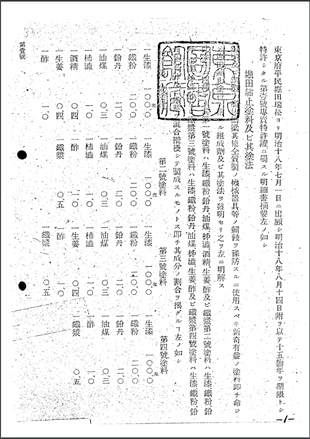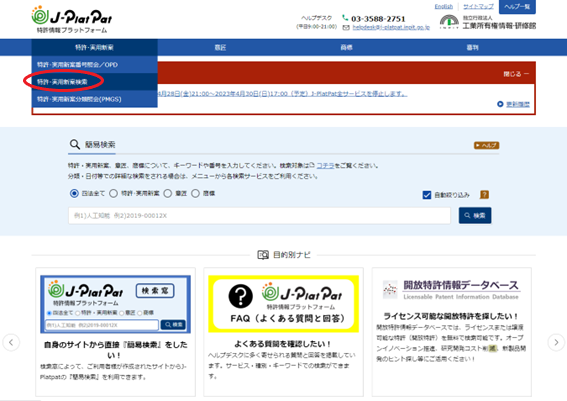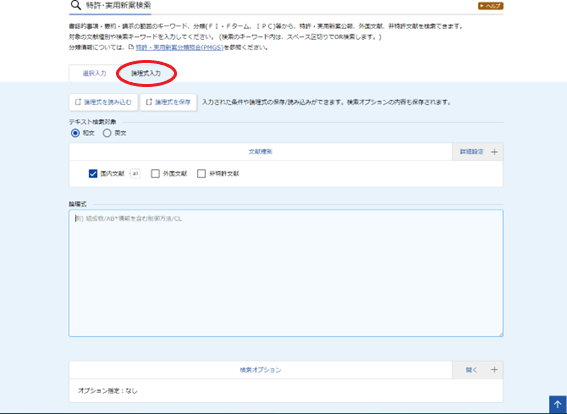J-PlatPat as database
2023.09.01 | search column
table of contents
XNUMX. XNUMX.Introduction
These days, there are many privately-operated patent databases, and I think that many people who conduct patent searches use one of these databases.The Japanese Patent Office also provides a database service on a site called J-PlatPat.Although it lacks a variety of services compared to databases operated by the private sector, it is worth using as it is the largest database of domestic patents.Therefore, in this column, I will introduce J-PlatPat as a database and its simple usage.
XNUMX.Public Dissemination of Patent Information
1 First, from the first exclusive patent certificate (Meiji 18)
Before the Meiji Restoration, various systems that had been implemented under the shogunate system were abolished, causing temporary confusion in the economic order, such as the overproduction of various products and the imitation of special products.On the other hand, the Meiji government was promoting modernization by actively introducing Western technology and promoting the establishment of government-owned factories (*1).For this reason, Korekiyo Takahashi, the first Director of the Patent Office, promulgated the "Regulations on Patent Monopoly" in 18.The first patent was filed on July 1, 18 by Mizusho Hotta, Tokyo Prefecture, for "Hotta-type anticorrosive paint and its coating method."
11 Appearance of public notice system (XNUMX)
The public notice system is a system in which patent office examiners notify the public (well-known) of applications for which they are convinced that they may obtain rights, and wait for patent oppositions.In the patent system of this time, all patent applications were examined, and those applications that could be granted rights were publicized through published patent gazettes.
46 Appearance of the Disclosure System (XNUMX)
In order to avoid duplication of inventions and patent applications, improve the efficiency of investment in research and development by society as a whole, and promote new inventions based on published inventions, patent applications are filed regardless of the stage of examination. has been made publicly available.
5 Converting patent information into text (XNUMX)
Following the start of electronic filing in 2, patent information has been published in text format since 5.As a result, until then, we had been searching by patent classification collectively, but now it is also possible to search by text (details will be explained later).After that, as can be seen from the document accumulation information (*2) of patents and utility models, OCR processing has progressed to text even in the publications that have already been published. It is text searchable.
1 Oldest publication (patent invention specification)
The oldest publication stored in J-PlatPat, the database of the Patent Office, is the patented invention specification "Patent No. 1" introduced earlier.It is a vertically written document like the one below.
XNUMX J-PlatPat as a database
It is no exaggeration to say that J-PlatPat, which has accumulated even the oldest patent publications, is the largest database of Japanese patent information.Most of the patent information databases operated by the private sector have accumulated data since 46, when the disclosure system began to operate, but J-PlatPat has accumulated all patent information since 18. I'm here.
In particular, it is characterized by the accumulation of "public utility model full text specifications".
A full-text specification of a published utility model is a full-text specification of a published utility model publication from 46 to 4.The published utility model gazette was published in 100 cases after trimming and editing only the so-called main parts, such as the scope of registered claims, all drawings, and brief explanations of the drawings (*3). part is not stated, and in order to see the specification, it is necessary to see the full specification of the published utility model.Although there are some private databases that provide partial support, I have personally never seen a database that fully supports full-text statements.
In this way, there are publications that can only be viewed with J-PlatPat, so I think it is worth using J-PlatPat.
XNUMX. Patent information search by J-PlatPat
XNUMX Classification search and text search
There are two main ways to search for patent information.There is a method of searching using patent classifications and a method of searching using text.Generally, when conducting a patent search, one selects a patent classification and picks up publications that have a given text within it.
Multiple systematically arranged classifications are assigned to all applications.A search using a patent classification is a method of selecting those classifications from the classification table and extracting the patent publications to which the classification is assigned from the database.
Text search, on the other hand, is a method that is commonly used on the Internet by entering several keywords and extracting publications containing those keywords.
XNUMX Search screen
There are two input methods for J-PlatPat: "selective input" and "theoretical formula input".
Click "Patent/Utility Model Search" on the J-PlatPat home screen (*4).
Select the Logical Expression Input tab.
Enter the search expression in the box labeled "logical expression".
Entering a formula is very simple.
XNUMX Input example
Let's take the field of fountain pens as an example and do a little search.
Fountain pens are categorized as "having a split nib" in the patent classification, and "B43K5/00,110" is an example of a patent classification given to inventions related to fountain pens.I will leave the details of classification for another occasion.
The following texts have been selected as texts related to fountain pens.
text group 1 → cap, cover
Text group 2 → clip, hook
Let's enter it.
In the case of "B43K5/00,110", which is a patent classification FI, it is described as follows.
B43K5/00,110/FI
When extracting patent publications that describe "cap" or "cover", describe as follows.
When the search target is the full text.
(cap + cover)/TX
When the search target is a summary.
(Cap + Cover)/AB
When the search target is a claim.
(cap + cover)/CL
If there are two or more conditions, just connect the conditions with " " and fill in.For example, to extract publications with the word "cap" or "cover" in the entire text from among the publications assigned the patent classification FI "B2K43/5", enter as follows.
B43K5/00,110/FI (cap + cover)/TX
"FI", "TX", "AB", and "CL" mentioned here are called structure tags.Various structure tags are available, and very detailed settings can be made by using the structure tags properly.
| Search items that can be specified in logical expressions | structure tag |
| full text | TX |
| Bibliographic matters | BI |
| Name/title of invention/idea | TI |
| Abstract/Abstract | AB |
| The scope of the claims | CL |
| Specification | SP |
| examiner free word | FW |
| Examiner free word + full text | AL |
| FI | FI |
| F-term | FT |
| facet | FC |
| IPC | IP |
| CPC | CP |
| Applicant/right holder/author affiliation | AP |
| applicant identification number | AN |
| Applicant/Owner Address | AA |
| inventor/creator/author | IN |
| Agent | RP |
| Examiner name | EX |
| referee number | JN |
| Priority claim country/region/number | PN |
| Paper title | TL |
| book title | BO |
| References | RF |
| the purpose | PI |
| Constitution | CI |
| detailed description | DD |
| Code explanation | DC |
| Description | BD |
| Description of the drawing | DF |
| Field of application | FA |
| Free word | CW |
| Conventional technology | BA |
| Invention disclosure | DI |
| Task | PS |
| means | MS |
| Effect | ED |
| Example | EI |
| The issuer | PB |
| Microorganism accession number | DN |
XNUMX Neighbor Search
J-PlatPat also supports neighborhood searches.Although it is a slightly advanced search method, I will briefly touch on the neighborhood search.Neighborhood search means extracting publications in which text group 1 and text group 2 appear within a specified number of characters. For J-PlatPat, the character spacing can be specified from 1 to 99 characters.You can also specify the order in which they appear, or make them appear in no particular order.
An entry example is shown below.
When "cap, cover" and "clip, hook" appear between 10 characters and you want to determine the word order in which they appear, enter as follows.
(Cap + Cover), 10C, (Clip + Hook)/TX
"Cap, cover" and "clip, hook" appear between 10 characters, and input in random order as follows.
(Cap + Cover), 10N, (Clip + Hook)/TX
The neighborhood searches that have been explained so far are examples of two-word neighborhood searches, but J-PlatPat also supports three-word neighborhood searches.An input example is as follows.
{text group 1,10, 2C, text group 5}, 3C, text group XNUMX/TX
Text Group 1,10, 2,5N, {Text Group 3, XNUMXC, Text Group XNUMX}/TX
{Text Group 1, Text Group 2, Text Group 3}, 10N/TX ← This notation can only be written in any order.
XNUMX.in conclusion
The method of publishing patent publications has also changed from paper publications to CD-ROMs, and now to J-PlatPat, which can be viewed easily as long as you have an Internet environment.J-PlatPat is the largest database of domestic patents, starting from the first patent to the latest patent publications.It is easy to imagine the many difficulties involved in converting paper patent publications into data and converting them into a format that can be viewed on the Internet.
J-PlatPat with the largest information of domestic patents.Why don't you all take a look at it once?
Research Division Seki
(*1) Patent Administration Annual Report 2018
https://www.jpo.go.jp/resources/report/nenji/2018/document/index/honpen0005.pdf
(*2) Accumulated document information (patent/utility model)
https://www.j-platpat.inpit.go.jp/html/c2000/patent.html
(*3) Characteristics of Japanese Patent Documents and Research Methods, Information Management, Vol.15, No.10
https://www.jstage.jst.go.jp/article/johokanri/15/10/15_703/_pdf
(*4) Home screen of J-PlatPat
https://www.j-platpat.inpit.go.jp/
【reference】
・Patent/utility model search page
https://www.j-platpat.inpit.go.jp/p0100
・Patent/utility model search help page
https://www.j-platpat.inpit.go.jp/help/ja/p01/p0101.html
・Regarding the input format and input examples of logical expressions
https://www.j-platpat.inpit.go.jp/help/ja/p01/arithmetic.html
Inquiry
For inquiries regarding IP research and inquiries about our business, please contact us.
Please feel free to contact us using this form.


